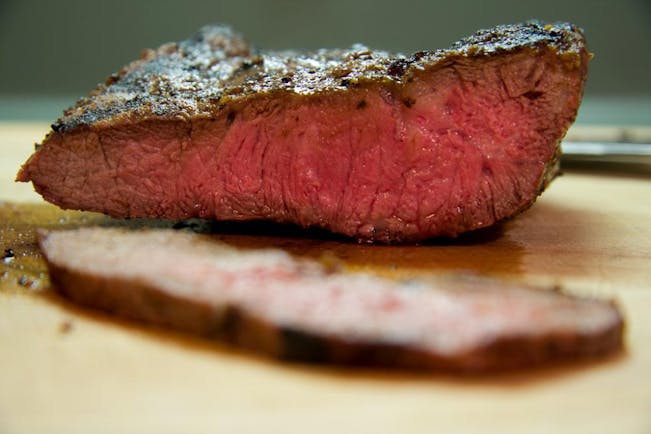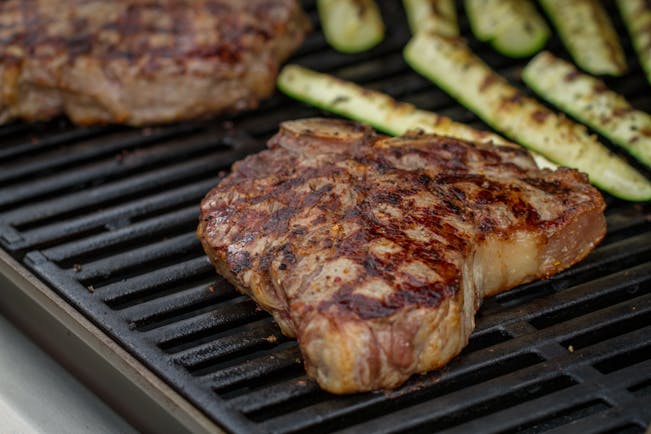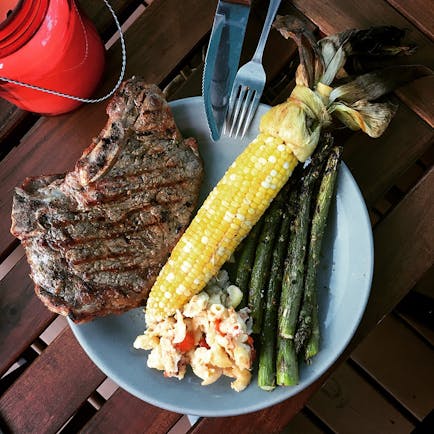6 Tips to Grilling A Perfect Steak
1. Salting early pays off
You might have heard the warning that you shouldn’t salt meat too far in advance of cooking because it can draw out moisture. It’s true that salt draws moisture towards itself, but over the course of 20 to 30 minutes that’s a good thing, because the salt begins to dissolve into that little bit of moisture.
When the steak hits the hot cooking grate, the sugars and proteins in the moisture combine with the salt and other seasonings to create a delicious crust. Any moisture you might lose is well worth the flavor of that crust.
2. Taking off the chill speeds up cooking
The goal of grilling a steak is to brown and lightly char the surface while also cooking the interior to a perfectly juicy doneness, right? If the steak is too cold, the interior might require so much cooking time to reach that perfect doneness that the steak overcooks deep below the surface, turning gray and dry.
Let your steaks stand at room temperature for 20 to 30 minutes before grilling. They will cook faster all the way to the center and stay juicer.
3. Searing equals flavor
One good habit that separates professional chefs from many home cooks is that chefs spend more time searing their steaks. They understand that searing develops literally hundreds of flavors and aromas on the surface of steak, so they let their steaks sizzle over direct heat until the surfaces are dark, dark brown.
Don’t let anyone tell you that searing “locks in the juices.” That’s a myth. But searing sure does make steak tasty.
4. Thicker steaks should slide over
Most steaks grill beautifully over direct high heat alone. The only time you might need to move them is if/when they cause flare-ups. However, some steaks are so thick that if you left them over direct heat alone, they would burn on the outside before they reached the internal doneness you like.
If your steaks are much thicker than an inch, consider the sear and slide approach. After you have seared both sides nicely over direct high heat, slide the steaks to a part of the grill that is not so hot, perhaps over indirect heat, and finish cooking them safely there.
5. You can’t put moisture back inside a steak
As steaks grill over high heat, they lose moisture. Fat and juices are literally pushed out of the meat. That’s the price we pay for making the steaks easier to digest.
Perhaps the most important part of grilling a steak is taking it off the heat before it has lost too much moisture. There is a short window of time, usually just a minute or two, when steaks go from medium rare to medium, or from medium to medium well.
Catching that window requires vigilance. Don’t walk away from a steak on the grill. And remember, it’s always better to take it off when it’s underdone and then return it to the grill than it is to let a steak overcook.
6. Time and Temperature
By monitoring your time and your temperature you avoid overcooking your food. Always have a good thermometer on hand such as an instant read thermometer for quick readouts for thinner pieces of meat or the iGrill for longer cook times or to monitor several pieces at once.
Did you know?
- Meat continues to cook even after it comes off the grill. On average, it will raise around 5 additional degrees, so if you want your steak to be at 125˚F, take it off the grill when it reaches 120˚F.
- As the old saying goes, timing is everything. It’s never truer than when you are trying to pull off a perfect meal at the grill. A rotary timer is adequate, but you can also use the timers in the Weber Grills app or on your mobile device, preferably one that can track multiple grilling times at once.
- You only have to overcook a fine cut of meat once to learn the importance of a good digital thermometer. Small and relatively inexpensive, an instant-read thermometer is essential for quickly gauging the internal temperature of meat when grilling. To get the most accurate read, insert it into the thickest part of the cut and avoid touching any bone, because the bone conducts heat.
©2017 Weber-Stephen Products LLC. Tips adapted from Way to Grill™ by Jamie Purviance. Used with permission.



